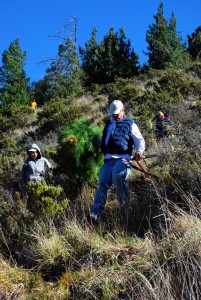
Join the Friends of Haleakalā for their annual pine pull – a chance to remove invasives and take home some locally harvested holiday greenery. Photo by Matt Wordeman.

Collecting pine trees Maui style. Though the snow may be lacking it still warms the heart. Photo by Matt Wordeman
Deck the halls with boughs of….holly? ‘Tis the season to decorate your hale with holiday wreaths, sprigs, and boughs.
Fresh greenery, seeds, and flowers are as much or more a part of this season as pretty paper and bows. Using plants to adorn homes during the winter solstice is a tradition that goes back to ancient times, as many cultures celebrated the return of the sun. Egyptians filled their homes with palms to celebrate the recovery of Ra, their sun god, from the illness that left the days shorter. Early Romans brought fir trees inside during their solstice feast of Saturnalia, honoring Saturn, the god of agriculture. Vikings honored the sun god Balder with pine boughs, and the Druids decorated their temples with evergreen boughs symbolizing everlasting life. Evergreens hold particular significance as they remain fresh throughout the year, no matter the climate.
Traditionally, all of these decorative plants were collected locally. It’s only in today’s era of globalization that our traditions are tied to imported plants and food. This year, consider revising your definition of traditional and decorate with locally grown plants. In doing so, you share your love of Hawaiʻi and help protect our island way of life for future generations.
Pine trees and garlands:
Few decorations are as iconic as the Christmas tree. But almost every year, agricultural inspectors hold and treat or even reject shipments of pines from the mainland because they contain hitchhiking pest species that threaten Hawaiʻi. Each tree is shaken to check for unwanted pests: slugs and yellow jackets are not uncommon, and in 2010 salamanders and Pacific tree frogs were found. The Vespula wasp made its way to our islands via shipments of Christmas trees in the 1970s.
Alternatives: If you consider evergreens a necessary ingredient for the holidays, you’ll be pleased to know there are locally grown pines available, for sale or for harvest. Each year groups like Friends of Haleakala National Park remove invasive pines from the slopes of Haleakala. Volunteer with them and you and your family can get a free tree. If you missed the December 12th event this year, mark your calendar to check the Friends’ website next year: www.fhnp.org
Wreaths:
A beautiful wreath of fresh foliage welcoming people to your home is a great way to set the tone for the holiday. Whether you create your own or purchase one ready-made, make sure the fresh decorations on your wreath are locally sourced. If you are using the reproductive parts of a plant (seeds or berries) it’s especially important to ensure that you are not helping spread an invasive pest or disease. For example, pampas grass has beautiful feathery plumes, but it’s a pest that the Maui Invasive Species Committee works to remove from Maui. Each plume is filled with thousands of wind-blown seeds that can compromise Maui’s watershed – not the message you want to send from your front door.
Alternatives: Locally grown pines, proteas, succulents, and herbs can be used to create beautiful and sturdy wreaths. If you need a little guidance, several organizations and local businesses have wreath making classes during December; Aliʻi Kula Lavender Farm still has classes so you can create a wreath in time for Christmas: www.aliikulalavender.com. Locally made wreaths are often available at farmers’ markets.
Houseplants and other vegetation:
Poinsettias are a holiday stable, and a houseplant or orchid is a great gift for the person who has everything. Purchasing plants from local growers lessens the likelihood that you’ll be giving an unintended gift.
Alternatives: Every year the Agricultural and Natural Resources Class at the University of Hawaiʻi Maui College grows poinsettias to sell as a fundraiser. Check the paper or the Facebook page for exact dates. Consider giving a native plant grown on Maui; ask your garden shop where the plants are grown.
Ancient and modern Hawaiians celebrate Makahiki at this time of year, a time of peace, feasting and festival, celebrating the prosperity of the land. It’s a time of family and gathering together, a time of creating and passing along traditions. This year, celebrate the prosperity of the islands and protect it for future generations. Hauʻoli makahiki hou from all of us at the Maui Invasive Species Committee.
Kia’i Moku, “Guarding the Island,” is prepared by the Maui Invasive Species Committee to provide information on protecting the island from invasive plants and animals that can threaten the island’s environment, economy and quality of life.
Written by Lissa Strohecker. Originally published in the Maui News on December 13th, 2015 as part of the Kia‘i Moku Column from the Maui Invasive Species Committee.


